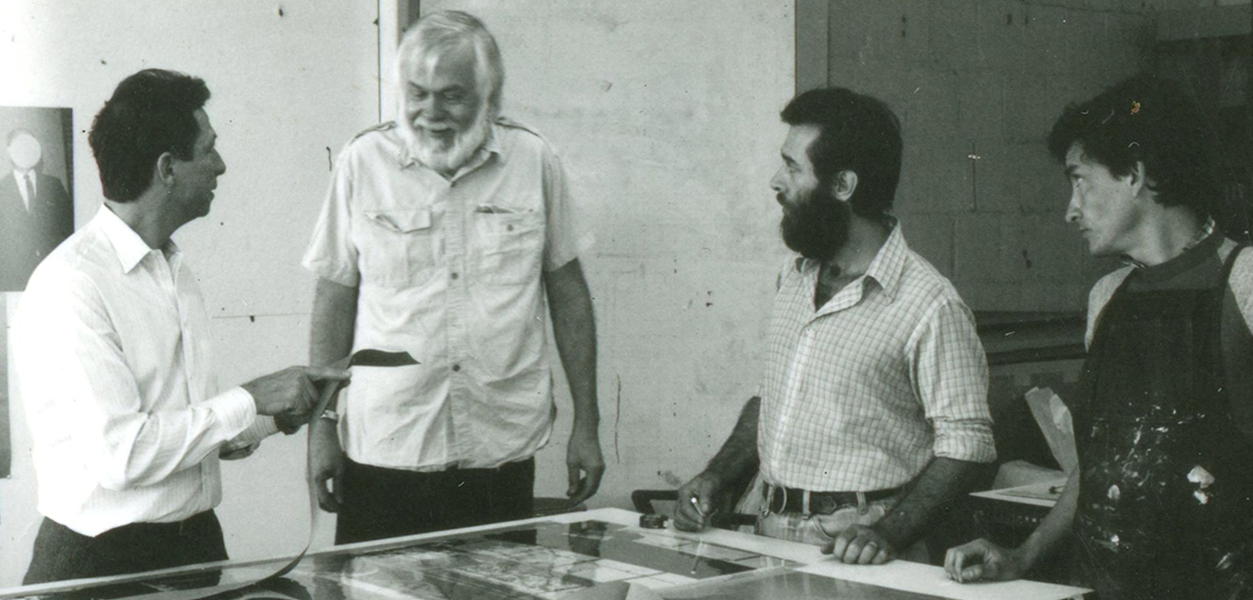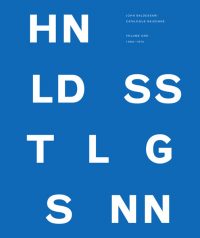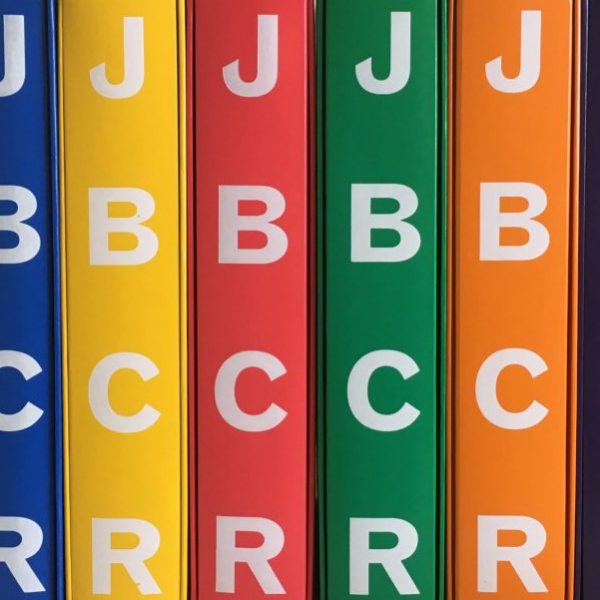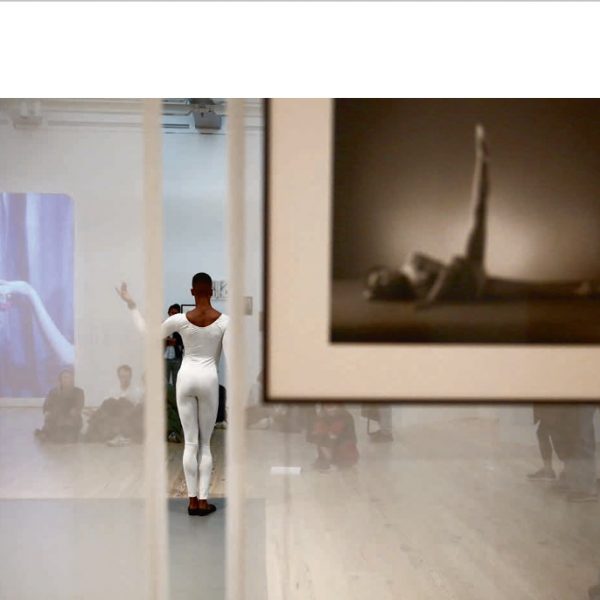The Making of John Baldessari’s Cremation Project
As promised, we give you a fascinating guest post by John Baldessari Catalogue Raisonné editors Patrick Pardo and Robert Dean, on pioneering conceptual artist John Baldessari’s most infamous project: the systematic destruction of his formative work. Check out our previous post for a great video on the evolution of Baldessari’s career.
Patrick Pardo and Robert Dean—
John Baldessari is probably best known for a single, creative act of destruction that took place on a Friday afternoon in San Diego, California, in the summer of 1970. On July 24, the artist, aided by friends and a group of students from the University of California at San Diego (UCSD), gathered up all his old paintings made between the years 1953 and 1966, drove them to a local mortuary, and burned them in the fires of a crematorium. He saved the ashes of the burned paintings and put some of them into an urn. He also had a bronze plaque fabricated in the style of a grave marker that recorded his full name and the dates “May 1953” and “March 1966”—thereby commemorating and putting to rest the early, pre-breakthrough phase of his artistic career. Baldessari initially gave the name “Cremation Piece” to the remains of this act of destruction; later he added a series of documentary photos and revised the title to the broader, more encompassing “Cremation Project.”
 The entry for the Cremation Project in the first volume of the artist’s catalogue raisonné is by far the longest and most complex. Invariably any general article about Baldessari, regardless of the type of publication, mentions the Cremation Project. Journalists and art historians alike know a good story when they hear one. He literally burned his own paintings? Description of the project affirms, to a degree, the figment in the popular imagination of the tortured, off-kilter artist. Why on Earth would he do such a thing? But to Baldessari, the decision to rid himself of his work was as much practical as therapeutic. At the time of the Cremation Project, Baldessari had just been hired to teach at Cal Arts and would be relocating, with his wife and two young children, from his hometown of National City to Los Angeles in order to be closer to his new job and to the larger L.A. art community. It didn’t make sense for Baldessari to transport and keep over one hundred paintings (work that no longer seemed relevant) stored in his vast studio, an old movie theater.
The entry for the Cremation Project in the first volume of the artist’s catalogue raisonné is by far the longest and most complex. Invariably any general article about Baldessari, regardless of the type of publication, mentions the Cremation Project. Journalists and art historians alike know a good story when they hear one. He literally burned his own paintings? Description of the project affirms, to a degree, the figment in the popular imagination of the tortured, off-kilter artist. Why on Earth would he do such a thing? But to Baldessari, the decision to rid himself of his work was as much practical as therapeutic. At the time of the Cremation Project, Baldessari had just been hired to teach at Cal Arts and would be relocating, with his wife and two young children, from his hometown of National City to Los Angeles in order to be closer to his new job and to the larger L.A. art community. It didn’t make sense for Baldessari to transport and keep over one hundred paintings (work that no longer seemed relevant) stored in his vast studio, an old movie theater.
The parameters for the works Baldessari destroyed in the Cremation Project were specific, as reflected in the affidavit Baldessari had published in the San Diego Union two weeks after the cremation: “all the works of art done by Baldessari between May 1953 and March 1966 in his possession as of the day of the cremation.” May 1953 was the date of his college graduation, a time when, according to Baldessari, he was no longer obligated to make art. The March 1966 milestone signified the date that he had given up relational painting and made the leap to the conceptual text and photo-text paintings of 1966-68. The additional qualification was that he only destroyed those paintings that were in his possession at the time. Works from this period that survive had either been sold or given away to patrons, family, and friends.
 The opening frames of a short documentary film that Baldessari shot with the help of some his students capture Baldessari making the first (and unsuccessful) attempts to destroy a large, early abstract painting. The painting rests at an angle, partially supported by a wooden railing. Baldessari takes a running start, jumps tentatively onto the canvas, then bounces off, the painting unharmed. It’s a comical but telling moment: Did Baldessari underestimate the strength of the stretched canvas, or was he questioning his desire actually to destroy the work in the first place? Whatever the answer, Baldessari moves ahead with his plan, and on his next run succeeds in jumping through the canvas. David Wing, who assisted in the filming, described Baldessari’s demeanor that afternoon as calm and business-like. During the process Baldessari’s chief assistant was a young man named Jon Pittman, who appears in much of the documentation and who was similar in size and stature to Baldessari.
The opening frames of a short documentary film that Baldessari shot with the help of some his students capture Baldessari making the first (and unsuccessful) attempts to destroy a large, early abstract painting. The painting rests at an angle, partially supported by a wooden railing. Baldessari takes a running start, jumps tentatively onto the canvas, then bounces off, the painting unharmed. It’s a comical but telling moment: Did Baldessari underestimate the strength of the stretched canvas, or was he questioning his desire actually to destroy the work in the first place? Whatever the answer, Baldessari moves ahead with his plan, and on his next run succeeds in jumping through the canvas. David Wing, who assisted in the filming, described Baldessari’s demeanor that afternoon as calm and business-like. During the process Baldessari’s chief assistant was a young man named Jon Pittman, who appears in much of the documentation and who was similar in size and stature to Baldessari.
The breaking up of the paintings into “bite-sized chunks,” as Baldessari described it, occurred outside of Baldessari’s UCSD office in La Jolla, a Quonset hut designated “Q311,” in the late afternoon. This became the staging ground for the removal and disassembly of the paintings from their supports, which was achieved by fist, ax, knife, foot, and hands, with the remains of the paintings transported in wheelbarrows (one even marked with the word “Art”!) to a central pile. The pile was then divided and loaded into three large cardboard boxes and three plastic bins, which were then put into the back of Baldessari’s Ford Econoline van. Baldessari found a local mortuary and crematorium, Cypress View Mortuary, that would handle this unorthodox request; the crematory operator had even studied art and was sympathetic to—or at least not completely taken aback by—Baldessari’s project. But he insisted that they burn the paintings at an off hour and quickly.
 The group drove to the back of the crematorium, where they waited for the retorts (ovens) to start up. By then it was early evening. Baldessari puffed on a pipe. There was tense anticipation, and then into one of the retorts went the three cardboard boxes and their contents. Into another retort went one of the plastic bins itself and its contents, as well as the contents of the remaining two plastic bins. The crematorium doors were shut. The paintings were incinerated, the twisted chunks of canvas and jagged bits of paperboard engulfed by orange flames.
The group drove to the back of the crematorium, where they waited for the retorts (ovens) to start up. By then it was early evening. Baldessari puffed on a pipe. There was tense anticipation, and then into one of the retorts went the three cardboard boxes and their contents. Into another retort went one of the plastic bins itself and its contents, as well as the contents of the remaining two plastic bins. The crematorium doors were shut. The paintings were incinerated, the twisted chunks of canvas and jagged bits of paperboard engulfed by orange flames.
The embers were collected and allowed to cool in metal containers. Baldessari and his assistants examined the ashes intently, emptying out some of them—still glowing—onto a paved area outside the crematorium. Once the ashes had fully cooled, the crematorium operator distributed them into nine small cardboard boxes (slightly smaller in size than a shoe box) and one smaller box. The larger boxes were used by the mortuary to hold the ashes of an adult. The smaller box, according to Baldessari’s recollection, would hold the ashes of a child or an amputated limb. The boxes were labeled “John Baldessari #34674.” In all, there were about 123 total paintings cremated. As equivalencies go, the burned remains of the paintings were equal in weight to those of nine adults and a child or an amputated limb.
And so, Baldessari, who had been taught by his father (a self-made and extremely resourceful man) never to be wasteful, created one large breakthrough work out of a hundred or so smaller ones. The project also represented the end of a particular period of his life, namely that of a regional abstract painter showing locally and finding little recognition beyond his circle of artist friends and the occasional review in the San Diego Union. There must have been something about the cremation that inspired or motivated him—perhaps a need to fill the void—for on the next day he did a multi-photo work called Equal Chicken Memories and wrote “39 Journal Entries”, which listed thirty-nine potential art pieces, including “Put all the paintings in the world together as one large painting.”
Robert Dean is editorial director and Patrick Pardo is research editor of the John Baldessari Catalogue Raisonné.



























